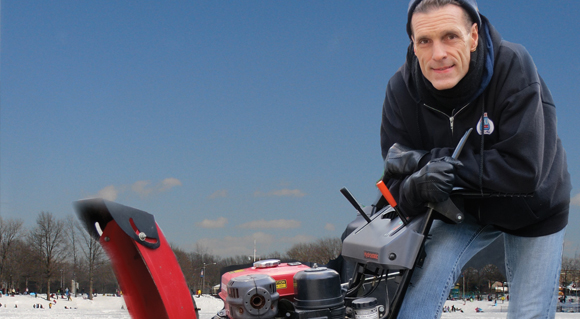There has yet to be a major snowfall that Eric Ritter has not used his snow blower to clear the sidewalks along 84th Street in Middle Village. The all too familiar sound of the snow blower plodding thru the snow, sometimes as early as three-thirty in the morning, has become a welcome sound to everyone who dreads the act of shoveling snow. Affectionately known as the “the snow blower guy” or “the phantom snowman,” Eric doesn’t do it for the money or the recognition like some service station owners would. Rather, he does it simply because he feels that “it’s the right thing to do” and “a good deed.” Eric is a selfless and community minded individual whose sense of volunteerism should be emulated by us all. Few of us have ever met him or know who he is since he clears the walks so early in the morning. For this reason, I decided to find out more about him.
Eric Ritter lives with his wife, June and their two cats, on 84th Street in Middle Village. He went to school in Clifton, New Jersey. He lived in California for 15 years and returned to Middle Village after he met his wife. They were married in 1986. Eric has been employed as an auto technician for Hillside Honda in Jamaica for over 25 years. He is also a land speed racer who recently traveled at speeds in excess of 300 miles per hour in his aerodynamic car at the Bonneville Salt Flats in Utah. He operates a Honda snow blower.
Q: Let’s start with the obvious question, why do you do it? Why do you use your snow blower to clear the sidewalks after every snowstorm?
A: I’m not a snow person. I’m not a winter person. I like sunny days, you know 90-degree days. I’m happiest in Death Valley at 132 degrees. It’s a terror removing snow. More people hurt themselves removing or shoveling snow, more than any other form of forced exercise out there. I mean, you grab a foot full of heavy, deep snow and you try to move it two feet. And after you shovel two or three feet, I don’t know about you, but I’m dead after three shovelfuls, and my back is killing me. When I moved back here from California, I said I am not going to shovel snow. I’m just not going to do it. And the other fact is that my dog got used to being walked to Furmanville and along the cemetery. It was a good excuse for me to say “alright, well I’ve got to walk the dog up to the cemetery over there, so let me go snow blow my way to the cemetery, and that’s really how it started. I wasn’t going to shovel snow and I needed to get up there to walk my dog. After the snow storms we had in the past couple of years, man, my dog was hopping from one sidewalk to the next, so I just said okay, well, I’m sure everybody’s going to love this, so I just plowed all the way up, and it wasn’t fair just to plow one side and go all the way up, I’m like, alright, I’ll plow the other side coming back down. And that’s what started it. After that it became a good deed to do for people. People seemed to appreciate it and sometimes that’s all you need.
Q: Let’s start with the obvious question, why do you do it? Why do you use your snow blower to clear the sidewalks after every snowstorm?
A: I’m not a snow person. I’m not a winter person. I like sunny days, you know 90-degree days. I’m happiest in Death Valley at 132 degrees. It’s a terror removing snow. More people hurt themselves removing or shoveling snow, more than any other form of forced exercise out there. I mean, you grab a foot full of heavy, deep snow and you try to move it two feet. And after you shovel two or three feet, I don’t know about you, but I’m dead after three shovelfuls, and my back is killing me. When I moved back here from California, I said I am not going to shovel snow. I’m just not going to do it. And the other fact is that my dog got used to being walked to Furmanville and along the cemetery. It was a good excuse for me to say “alright, well I’ve got to walk the dog up to the cemetery over there, so let me go snow blow my way to the cemetery, and that’s really how it started. I wasn’t going to shovel snow and I needed to get up there to walk my dog. After the snow storms we had in the past couple of years, man, my dog was hopping from one sidewalk to the next, so I just said okay, well, I’m sure everybody’s going to love this, so I just plowed all the way up, and it wasn’t fair just to plow one side and go all the way up, I’m like, alright, I’ll plow the other side coming back down. And that’s what started it. After that it became a good deed to do for people. People seemed to appreciate it and sometimes that’s all you need.
Q: Where you aware at the time how much you were helping people?
A: No… I just know that for older people especially, it’s a terror to shovel snow. Some people just can’t get out there to do it, because it’s too tough for them to do. I can, so I do it. And I don’t want to see anybody out there having a heart attack on the street, because that I might not be able to help them with, but moving the snow, yeah I can help them. So, I said, alright, I’m going to find myself a snow blower, and I did some research to find out how much snow various models moved, and how well each one worked, and I ended-up buying a Honda snow blower, I know what you’re thinking, but it’s true, Honda does make a really good snow blower. If you want something that’s going to do its job, you’re going to get one.
Q: What time do you start?
A: Generally three thirty in the morning. And if the snowfall is heavy I’ll do it again later.
Q: What would you say if I told you that after a heavy snowfall that my neighbors and I on 84th Street welcome the sound of your snow blower?
A: I’d say I’m glad and I’m glad to do it. There was one guy who complained though, once. He doesn’t live on this block anymore. He said he was trying to get his sleep. But he’s the only one.
Q: What would you say to the people who haven’t met you?
A: I’m glad to do it for you.
Q: Where do you clear? How far do you go? How many blocks?
A: All the sidewalks on the blocks from Penelope Avenue to Furmanville Road (Middle Village), both sides. I also clear the bus stop on Penelope by 84th St.
Q: Have your neighbors showed their appreciation for plowing their sidewalks?
A: Yes. Some people have let me know that they are thankful. Some people have offered or given me coffee, cake, cookies, and hot chocolate. As a matter of fact, two of my neighbors on the next block, Valerie and Dominic Catalano gave me cookies from their bakery. Some people try to give me money, but I don’t do it for people to give me money. That’s for sure. But one year, one neighbor went around collecting money for me, and I got it, I wrote thank you letters back to everybody.
Q: Was there ever a time you were unable to clear the sidewalks?
A: After the microburst or tornado hit and because of the damage to the house, we had to move to an apartment in Forests Hills. And when it snowed that heavy soon after, I couldn’t get out of my apartment building and to get over here.
June Ritter: We were in a temporary apartment and he says” there’s a lot of snow coming down, I’m going to walk from Kew Gardens to Middle Village and I’m going to snow blow the street. And I said, “No, you’re not!”
Q: Apart from this, what achievement are you most proud of?
A: My marriage. We have a really great relationship. It’s definitely what I’m proudest of.
Q: What is the one thing you’d like to see changed in our community?
A: I think the neighborhood has become more friendly then years back. People are always out there talking to each other. And I like it when people say “hi” to each other. You don’t have to know everybody’s business, but just to say “hi” I think is a cool thing.
Q: I understand you’re involved with land speed racing and that you race your streamliner car out west on the salt flats each year. How did you get involved with that?
A: At nine years-old I was into NASCAR. At that point I wanted to race cars, but it turned into motorcycle racing. I had to convince my mother to race bicycle motor cross. I finally convinced my mother to do that, and she said “you’re going to turn to motorcycles after this “ and sure enough, I did. I met my wife road racing motorcycles. After that I connected with land-speed racer, Don Vesco and became part of his race team in 1987. And I’ve been doing land-speed racing ever since.
Q: What’s it feel like to travel at a speed in excess of 300 MPH?
A: It’s cool. It’s a rush. It’s like being on a plane taking off on a runway. That’s the closest you can describe it and you want more and more of that. That’s what it comes down to. A jet leaves the tarmac at 175 MPH.
Q: What’s your goal? What speed are you looking to exceed?
A: I would like to travel over 500 miles an hour, which was Don Vesco’s dream. Don Vesco was my mentor. Unfortunately, he passed away.
Q: You’re not planning on trying this on Furmanville Avenue are you? Because we have enough speeding going on there .
A: No. (Laughs). In Utah.
Q: Who were your role models growing-up?
A: I can honestly say I didn’t have one.
Q: Apart from driving, what other interests do you have?
A: I like roller-skating, and I like my musical instruments, like my sax, although I really don’t play very much anymore. I also like to DJ. I DJ music for the roller skaters in Central Park. I really like to play music for the roller skaters because they need a certain type of genre and the music has to flow the right way. That I learned from an experienced guy, named Julio Estein, who is no longer with us. He taught me everything he knew and I listened to him back in the day at Roxy Roller Skating Ring in New York City. He was the DJ there for years. We hit it off and I would go and visit him and he would let me play and spin for an hour or so and I was like “man, I can’t believe he’s letting me do this!” And after that I started doing my own thing. I’m also a good roller skater.
Q: What is the one thing about Eric we would be surprised to know?
A: I’ll let my wife answer that.
June Ritter: How much of a perfectionist he is, and how talented he is musically. You should hear him play the sax!




